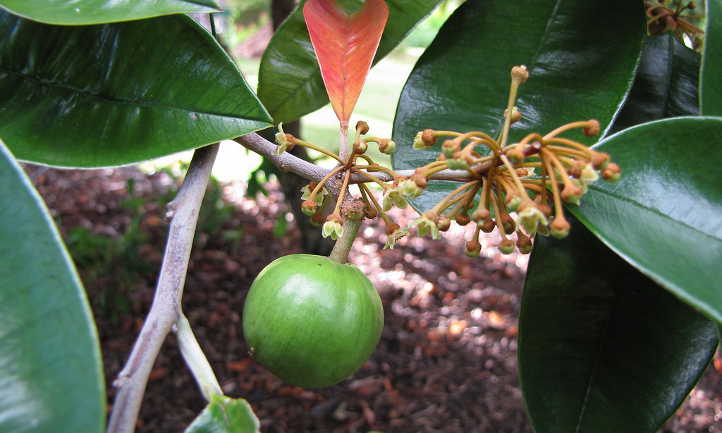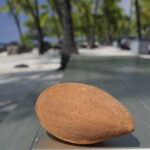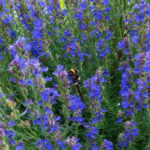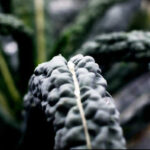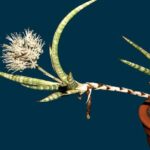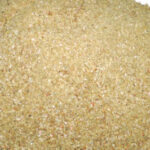Have you ever had a star apple? If not, this tasty fruit is definitely something to try.
Star apples aren’t actually apples, but a tropical fruit commonly grown in South America and Asia. In the US, they’re usually only found in Hawaii and Florida (great for tasting while on vacation!) The outside of the fruit is dark purple and shaped like a round apple. When cut open, the edible pulp is soft and milky, with seeds in the shape of a star. Because it tastes so sweet, star apple is often used in fruit salads and desserts.
The fruit isn’t the only allure here! The tree itself is quite beautiful. Leaf tops glow a glossy green and underneath is a gorgeous shade of gold. This has an enticing effect when the foliage rustles in the breeze. Because of this, star apple trees are great ornamentals as well as fruit producers.
Quick Care Guide

| Common Name(s) | Star apple, goldenleaf, milk fruit |
| Scientific Name | Chrysophyllum cainito |
| Month(s) Of Harvest | Late winter to early summer |
| Light | Full sun |
| Water: | Deep, consistent waterings |
| Soil | Well-draining |
| Fertilizer | 3-4 times a year |
| Pests | Red algae, fruit flies, moth larvae |
| Diseases | Algal leaf spot, dry rot, fungal root rot |
All About Star Apples
A tropical plant, Chrysophyllum cainito usually only grows in its native lands as well as Hawaii and southern Florida. If you live in zones 10-11, this tree may be the perfect fit for you. Unfortunately, it’s not suited for growing indoors.
Full-grown trees can reach 25 feet or higher. With proper pruning, they can be trained to grow a bit smaller. The canopy is round and dense, making it an excellent source of shade. Plus, it rarely drops fruit on you! Unless there’s a strong wind that dislodges fruits, they will remain on the plant and dry into hard round balls.
In late summer and fall, it produces cone-shaped clusters of purplish-white flowers. The harvest is ready by late winter or early spring. These trees are self-fruitful, meaning that they do not need a second tree to cross-pollinate.
Cainito is said to have a distinctive aroma at night when it attracts nocturnal pollinators. The scent is alternately described as “earthy” or “unpleasant”. This lures in the right kind of insects to handle its pollination.
Chrysophyllum cainito is often misspelled as Caimito. This means it’s often confused with Pouteria caimito, also called Abiu. They’re very different species, so take that into consideration when you’re purchasing your plant.
Recommended Varieties
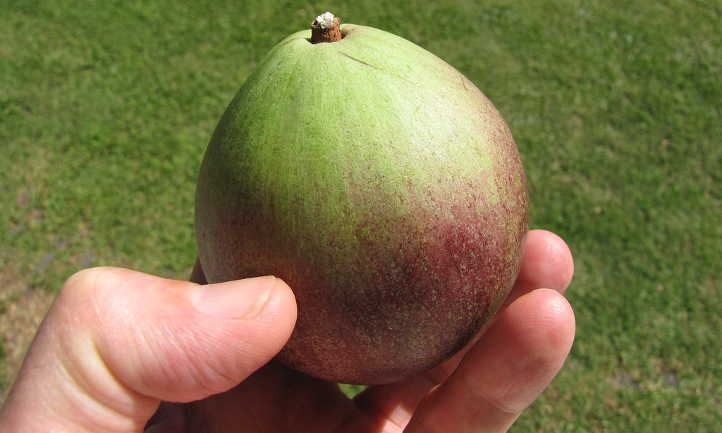
| Variety | Description | Where To Buy |
| Haitian Star | A common variety that has purple-red skin. | Buy Seeds |
| Blanco Star | This variety is greenish-yellow and slightly smaller than the Haitian Star. | Buy Seeds |
Planting Cainito
When planting your star apple, make sure it has a stable environment where it can thrive. If you give it the special care it needs as a young tree, you’ll be rewarded with delicious fruit!
When to Plant
This species is commonly grown from seed, but can also be bought as saplings. If you purchase a sapling, choose one that’s healthy and young. Older ones are more likely to be rootbound. It can be planted anytime from spring to fall, and even in the winter in the warmest regions.
Where to Plant
Zones 10-11 have the right climate to grow this plant. It needs an outdoor location with little wind. Strong wind can strip the leaves and damage the plant, especially young saplings. These do not perform well when grown indoors.
Choose a location that’s in full or partial sun. Cainito can be planted in a large, sturdy container as an ornamental, but won’t produce many fruits. If planted in the soil, they can be quite large and require lots of space. 10-25 feet between trees is recommended.
How to Plant
The seeds germinate easily and are viable for several months. Plant them about an inch deep in a small container kept outdoors. Once the seeds have established roots and are actively growing, you can transplant into the ground or a larger container.
If you chose to start with a sapling, it can be planted straight in the ground. Dig a hole that’s 3 times wider and deeper than the root ball. Once you’ve done that, backfill the hole until it’s the correct size. It seems counter-intuitive, but doing this loosens the soil enough to allow the roots to easily spread out.
Now, you can stick the star apple into the hole and fill in the rest of the soil. Lightly pack down the top to collapse any large air pockets. If necessary, you can place stakes on either side of the trunk and use natural fiber twine or strips of cloth to support the tree. Avoid using slender wires, as those can cut into the bark.
Care
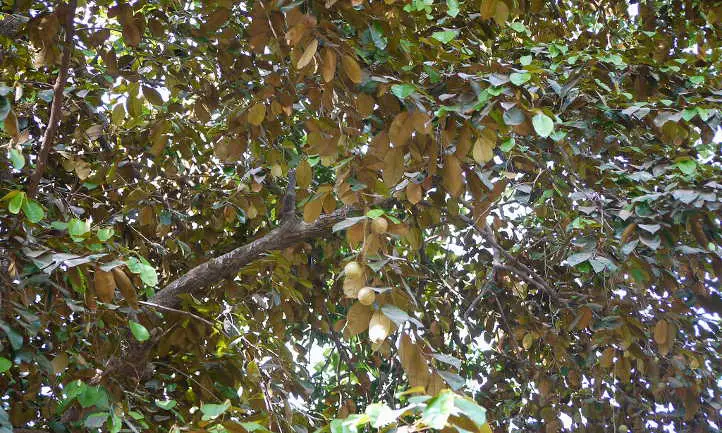
Once established in the right environment, these are easy to care for! Here’s our top tips for star apple success.
Light & Temperature
As a tropical plant, cainito needs full sun and heat. It handles partial light well but isn’t flexible when it comes to temperature. Freezing temperatures and frost cause damage and may even kill the plant. Saplings are most at risk from cold damage.
The temperature should always remain above 40° F. Anything colder may cause leaves to drop.
Water & Humidity
The cainito transpires, which means it releases moisture through its bark the same way humans sweat. Hot weather increases the transpiration, so it needs plenty of water. After planting, water your baby tree at least every week for the first 6 months, and more if the soil dries out quickly. After that, you can water less frequently, but still deeply. Soaker hoses can provide slow, even moisture dispersal.
Hold back on watering during late fall and early winter while the tree prepares to flower. Once it does bloom, frequent watering is required to boost fruit production.
Keep in mind that star apple does not need excessively wet soil. If it’s consistently overwatered, the roots can rot.
Soil
This species is pretty versatile when it comes to soil and pH. It grows well in a variety of soil types. However, the soil has to have good drainage. Otherwise, the tree can easily be overwatered.
Mulching is optional but prevents soil moisture evaporation and keeps weeds at bay. Apply 3-6″ deep in a circle that roughly mimics the width of the tree’s canopy. Leave at least 6″ of space between the mulch and the trunk itself to prevent potential rot damage.
Fertilizing

Some tropical areas have highly fertile soil that doesn’t need amendment. However, if your soil is poor, you may need to provide additional fertilizer. This should only be applied to the topsoil and not underground when the tree is planted.
Fertilize every other month for the first year of the tree’s life. After that, only fertilize once per season. A standard fruit tree fertilizer should work just fine for this plant.
Alkaline soils may prevent this plant from taking up iron and other nutrients. If you notice the leaves yellowing, this is called chlorosis, and is often caused by an iron deficiency. Chelated iron can provide enough iron for the tree to stay green and healthy.
Pruning / Training
Pruning is necessary for keeping your chrysophyllum cainito at an ideal size. Because fruits don’t fall off when ripe, maintain it at a height that you’re able to harvest. Prune as needed every 1-3 years to keep it in shape. When the tree is mature, maintain a bush canopy, which will boost fruit production.
Training while the sapling is young makes for a healthy and durable mature tree. This species often develops multiple trunks. Select the healthiest of these trunks to keep and prune off others at ground level, making it a single-trunked tree.
Sterilize the blades of your loppers or pruning shears before making cuts. This reduces the spread of plant diseases.
Propagation
Star apple trees can be grown from seed, though it will take 5-10 years to produce fruit.
Cuttings taken from mature wood can produce roots well. Follow standard cutting care methods while trying to coax them to take root. Some rooting hormone can come in handy.
If you have an older plant that has lost branches to damage but is still otherwise healthy, grafting new branches onto old rootstock is a good option. This method tends to be very effective.
Chrysophyllum cainito can also be grafted on the satinleaf tree (Chrisophyllum oliviforme L.). The result is a smaller, slower-growing plant, so this method is not always recommended.
Harvesting and Storing
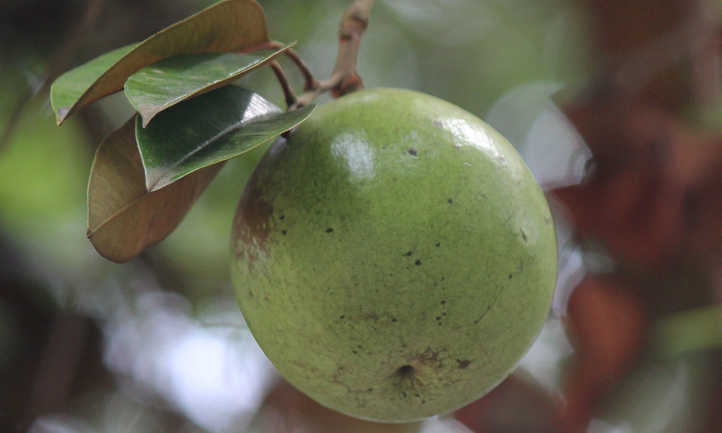
These sweet purple and green fruits require a good amount of effort for harvesting, but it’s worth it. The high yields will keep your fridge stocked up!
Harvesting
Mature plants bear fruit from late winter to early summer. Fruits don’t fall off on their own very often, so it all has to be hand picked. Star apple fruit only ripens on the tree, so pick them when they’re ready!
When it’s ripe, the produce will be dull in color, slightly soft, and a little wrinkled. If the skin is shiny, it’s not quite ripe yet.
Unripe fruits have inedible and sticky white spots of latex on the inside. Fully ripened, the pulp should be soft and sweet, free of sticky latex.
Harvest the milk fruit by clipping it from the tree. Pulling it off can cause damage to stems and branches.
In one season, these trees can produce up to 150 pounds of fruit. Prepare for lots of picking!
Storing
Star apples are best eaten when fresh but can be stored short-term. They refrigerate well for about 2-3 weeks. The cold air slows the ripening process, making the fruit last longer, but doesn’t stop it. Fruit that’s slightly unripe may not fully ripen if refrigerated.
Cut fruit stored in a plastic bag will keep for about a week in the fridge. If uncut, it can be stored in an open plastic bag in the fridge for a few weeks. You can freeze the pulp, but its texture will be somewhat altered.
For long-term storage, search for cainito recipes that can be stored in a more traditional method. Dehydration or freeze-drying is not commonly used, but there are recipes for frozen sherberts and jellies available. Due to its high sugar content and high water content, it can spoil quickly once harvested if not preserved in these fashions.
Troubleshooting Star Apple Tree

Chrysophyllum cainito generally has few problems when it comes to pests and diseases. However, you should inspect them regularly so that any issues can be caught early on.
Growing Problems
As mentioned in the fertilizer section, star apple trees are susceptible to iron deficiency. Supplementing the soil with chelated iron will help remedy this. Gradually neutralizing the soil’s pH from an alkaline state will also improve iron absorption.
Damage to the trunk can severely impact the tree’s health. To prevent damage from lawnmowers, keep the ground grass-free at least a foot around the trunk. Don’t use a weed trimmer around the trunk.
Pests
Fruit flies are a common nuisance in the kitchen, but can affect fruit on the tree as well. These pesky flies lay eggs on ripe fruit and carry potentially harmful bacteria. To prevent them, harvest ripe fruit and keep the area clean. Control existing populations with fruit fly traps.
Lepidoptera (moth) larvae may eat the flowers and fruit. Prevent this by setting pheromone traps to diminish the population. If the pests are out of control, use BT spray to eliminate them.
Diseases
Red algae can attack the leaves, trunk, and branches. It forms grey or reddish spots, adds weight to the tree, and can split the bark. The algae growth is often a symptom of other problems with the tree’s health, such as root rot. Remove algae manually or by spraying it with a liquid copper fungicide.
Algal leaf spot, also called green scurf, creates nasty spots on leathery leaves. In time, it makes the leaves yellow and drop from the tree. Like red algae, the tree is most vulnerable to it if it’s not healthy. Common treatment methods for leaf spots will help. Remove dead/diseased leaves from the tree and ground. Ensure it’s pruned to allow airflow through the tree’s canopy.
Star apples can get dry rot if they’re not harvested when ripe. This is usually caused by infections of fungi or bacteria. The infection causes the fruit to shrivel, dry, and “mummify”. Prevent it by pruning for good aeration and keeping the tree and area clean. Harvest when the fruit is ripe.
If overwatered, various fungal root rots can set in. As these can kill the tree, prevention is your best option.
Frequently Asked Questions
Q. How do you eat a star apple?
A. Slice the fruit open and spoon out the pulp like a grapefruit. The skin, core, and rock-like seeds are inedible, so avoid those. Star apples are best eaten fresh, chilled, or in desserts.
Q. How long will it take for a star apple to grow fruit?
A. When grown from seed, it can take from 5-10 years to bear fruit.
Q: What does star apple fruit taste like?
A: It’s a tropical, sweet fruit. The edible pulp is reminiscent of a blend of persimmons, apples, and lychee. Remember that the skin is inedible, as are the seeds.

